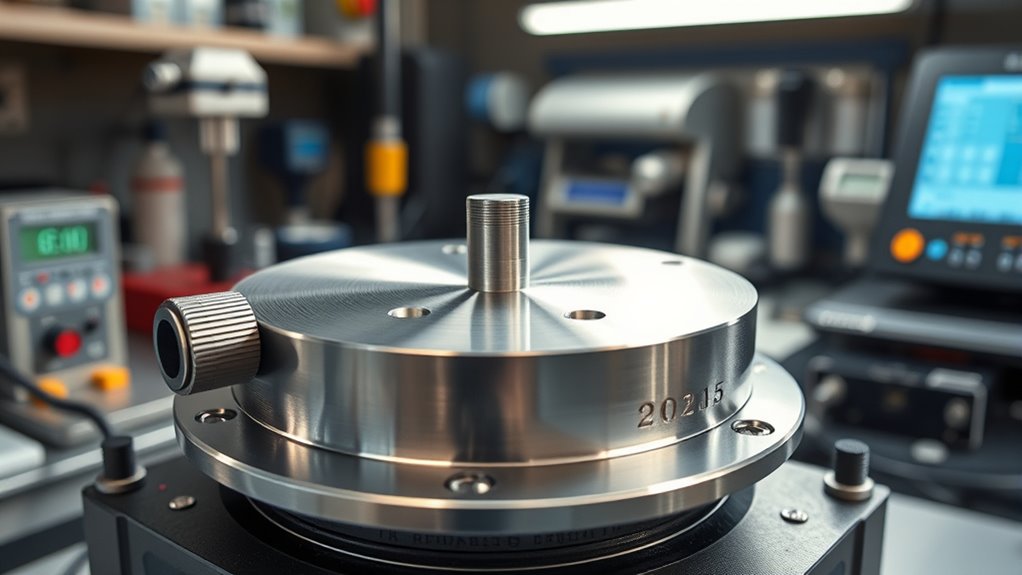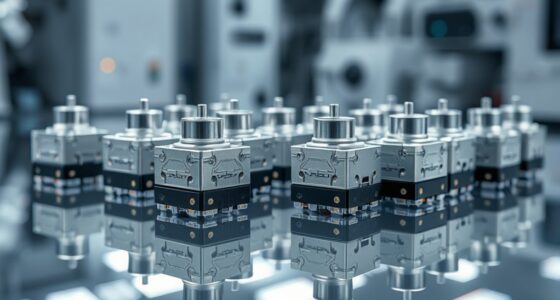If you’re looking for the 14 best high-resolution rotation stages for precision engineering in 2025, I recommend considering models that prioritize durability, smoothness, and fine control. Look for stages made from hardened stainless steel or anodized aluminum, offering resistance to wear and deformation. Features like backlash minimization, adjustable tension, and precise micrometer-driven mechanisms are key. Stay tuned as I’ll share detailed options that combine durability and high accuracy for your projects.
Key Takeaways
- Focus on stages made from hardened stainless steel or anodized aluminum for durability and corrosion resistance.
- Prioritize models with high-resolution encoders and minimal backlash for precise angular control.
- Ensure smooth, backlash-free rotation using high-quality ball or roller bearings with tension adjustment.
- Check for compatibility with existing optical systems, mounting interfaces, and load capacities exceeding sample weight.
- Opt for stages with fine adjustment controls, ergonomic design, and 360-degree rotation for versatile precision applications.
AmScope B490 Compound Binocular Microscope
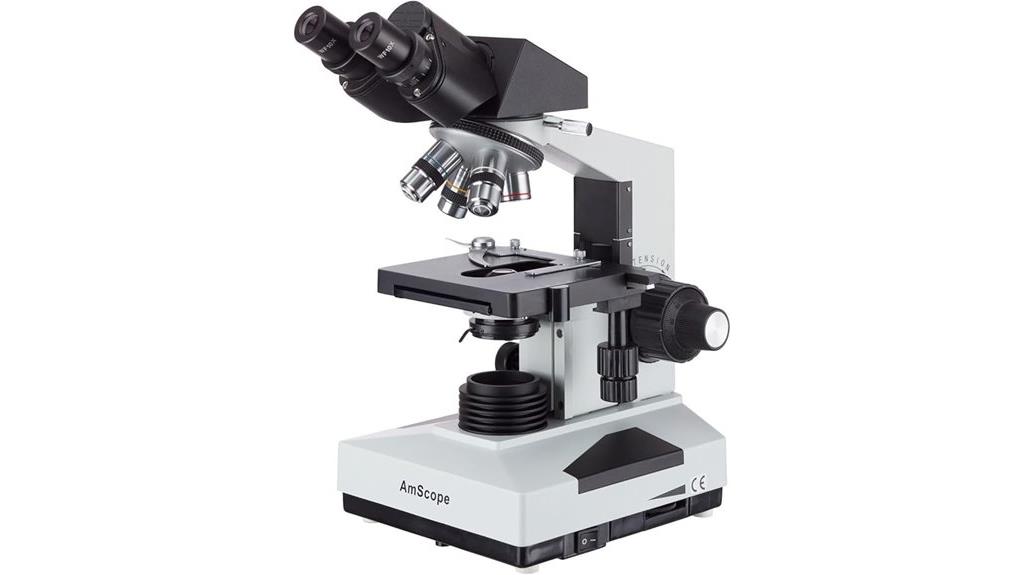
The AmScope B490 Compound Binocular Microscope is an excellent choice for educators and researchers who need precise, high-resolution imaging with reliable stability. Its solid-metal, enamel-coated body resists stains and corrosion, ensuring durability. The sliding head with 10x widefield eyepieces, adjustable interpupillary distance, and 360-degree rotation makes sharing and viewing comfortable. Equipped with four DIN achromatic objectives (4x, 10x, 40xS, 100xS), it offers versatile magnification options. Brightfield halogen illumination, adjustable via rheostat, provides clear, bright images. Its sturdy mechanical stage and precise focusing mechanisms make it ideal for detailed biological and industrial observations.
Best For: educators, students, and researchers seeking a durable, high-quality microscope for biological and industrial applications.
Pros:
- Robust solid-metal enamel-coated body resists stains and corrosion for long-lasting durability
- Versatile four-objective system with 40xS and 100xS spring-loaded lenses for protection against slide damage
- Adjustable interpupillary distance and 360-degree rotating head enhance comfort and sharing
Cons:
- Lacks built-in digital imaging or camera integration for capturing images directly
- Does not include immersion oil, requiring separate purchase for high-magnification oil objectives
- Slightly bulky size may be less portable for field use or mobile labs
AmScope B490A-LED Compound Binocular Microscope
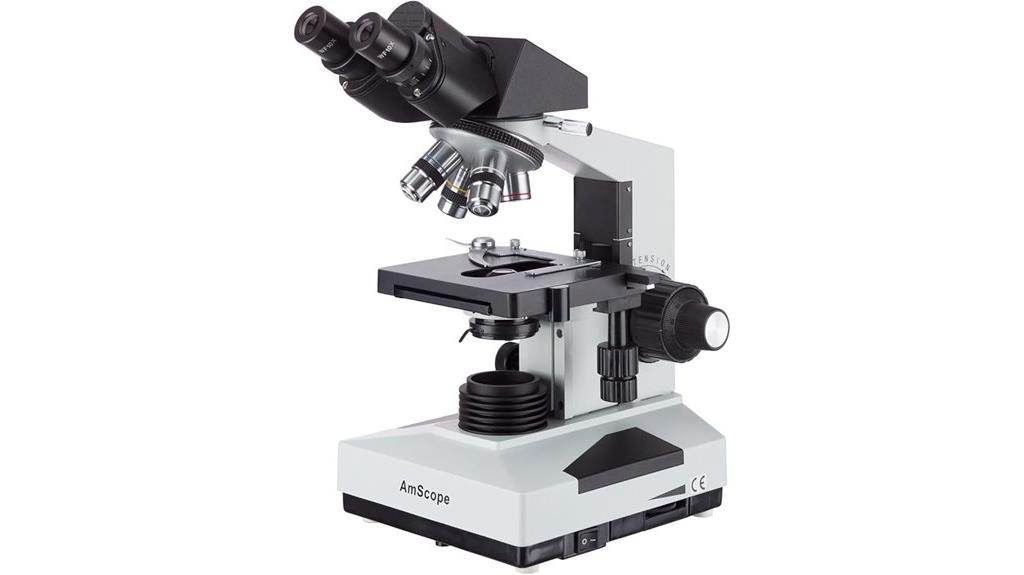
If you’re seeking a microscope that combines high magnification with precise control, the AmScope B490A-LED Compound Binocular Microscope is an excellent choice. It offers magnification from 40X to 1600X, perfect for biological, educational, and lab work. The adjustable interpupillary distance and fixed 30-degree inclination reduce eye and neck strain, while the 360-degree rotation makes sharing easy. Equipped with interchangeable 10x and 16x eyepieces and four DIN achromatic objectives, it ensures clear, detailed images. Brightfield LED illumination with rheostat control provides adjustable lighting, and the sturdy metal body guarantees durability. It’s versatile, reliable, and designed for detailed specimen analysis.
Best For: biology students, researchers, and laboratory professionals seeking high magnification with precise control for detailed specimen analysis.
Pros:
- High magnification range (40X-1600X) suitable for detailed biological examinations
- Adjustable interpupillary distance and 360-degree rotation for comfortable sharing and customization
- Durable metal body with high-quality optics and LED illumination for clear images and long-term use
Cons:
- Slightly heavier and larger, which may reduce portability for mobile use
- Requires careful handling of objectives and slides to prevent damage to spring-loaded components
- May be more expensive compared to entry-level microscopes with fewer features
AmScope T490B-5MT Digital Trinocular Microscope
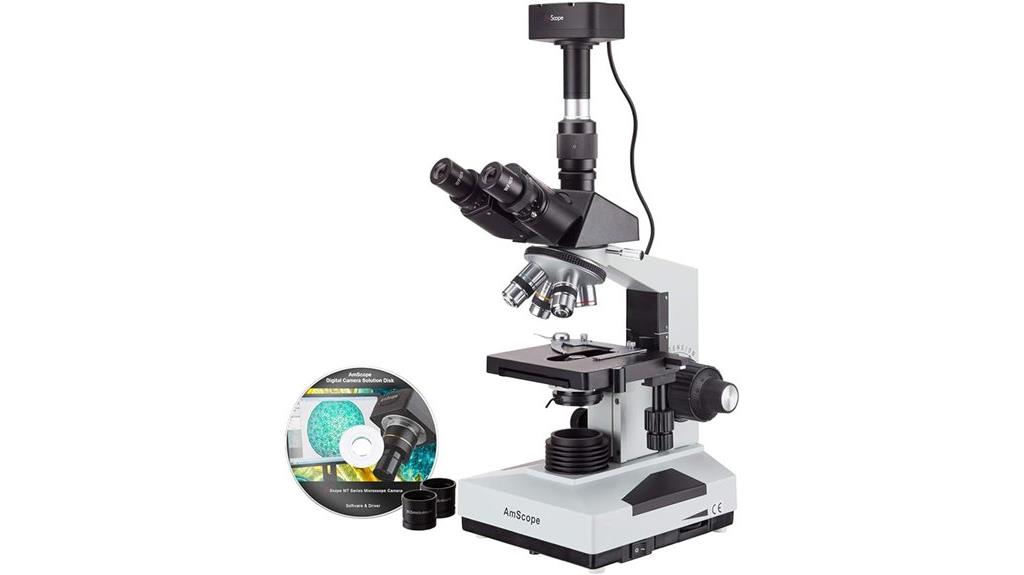
Designed for detailed examination and documentation, the AmScope T490B-5MT digital trinocular microscope offers precise focus control and versatile imaging capabilities that make it an excellent choice for those needing high-resolution imaging in precision engineering. Its sliding head, adjustable interpupillary distance, and 30-degree vertical inclination reduce eye and neck strain, while the four DIN achromatic objectives provide clear, high-quality images. The 5MP CMOS camera captures sharp stills and live videos with adjustable magnification. The brightfield halogen illumination, combined with a 1.25 NA Abbe condenser, guarantees ideal lighting. Overall, it’s a durable, feature-rich microscope perfect for research, inspection, and detailed documentation.
Best For: hobbyists, educators, and professionals requiring high-resolution imaging and detailed documentation in biological, engineering, or research applications.
Pros:
- Offers high-quality 5MP digital imaging with live video streaming and versatile software tools.
- Ergonomic design with adjustable head, interpupillary distance, and vertical inclination reduces eye and neck strain.
- Durable, stain-resistant construction coupled with high-precision optics and brightfield halogen illumination for clear, detailed views.
Cons:
- The halogen illumination may generate more heat and consume more power compared to LED alternatives.
- Requires compatibility with Windows, Mac, or Linux systems, which might necessitate additional driver installation.
- Optical magnification is limited to 40x with the camera, so for extremely high magnification needs, an additional lens or system might be required.
AmScope T490B-DK Compound Trinocular Microscope
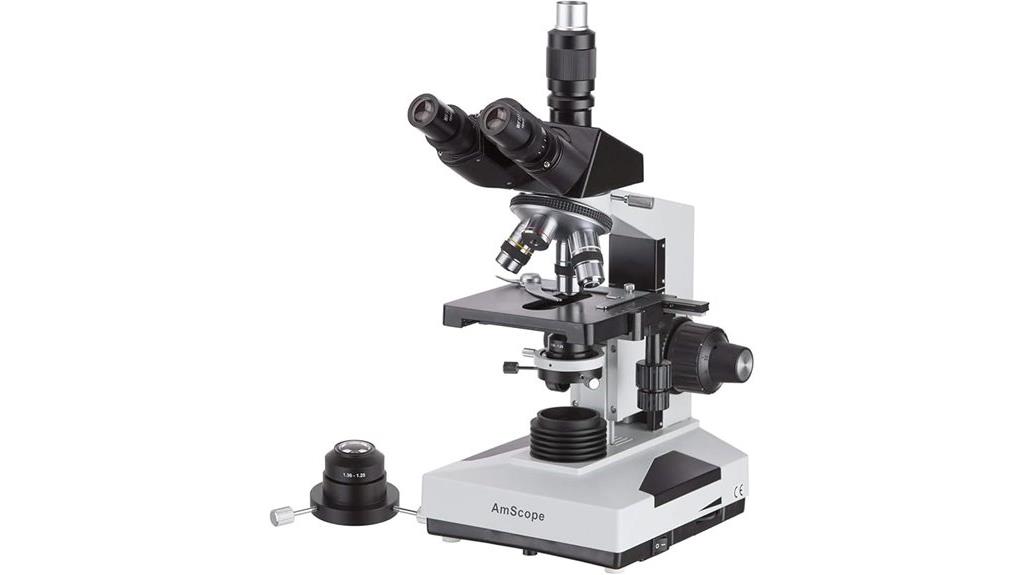
As someone seeking high-quality microscopy for detailed biological or research work, you’ll appreciate the AmScope T490B-DK Compound Trinocular Microscope’s versatile optical system. It offers magnifications from 40x to 2000x, ideal for inspecting specimens and conducting dissections. The fixed 30-degree inclined, rotatable binocular head with a vertical camera port makes sharing and capturing images easy. Equipped with interchangeable WF10x and WF20x eyepieces and four DIN achromatic objectives, including oil immersion, it delivers clear, color-corrected views. Its brightfield and darkfield halogen illumination, combined with precise X-Y stage movement and coarse/fine focus, make it a reliable tool for demanding scientific applications.
Best For: biological researchers, educators, and professionals needing high-magnification, detailed specimen analysis and imaging.
Pros:
- Versatile optical system with magnification range from 40x to 2000x, suitable for detailed observation and dissections.
- Equipped with adjustable illumination and precision X-Y stage for accurate positioning and optimal image clarity.
- Durable, corrosion-resistant construction with comprehensive accessories, ideal for laboratory and research environments.
Cons:
- Relatively heavy and large, which may impact portability and space requirements.
- User ratings average around 3.8 out of 5, indicating some variability in user satisfaction.
- Price may be higher compared to basic microscopes, reflecting its advanced features and build quality.
Celestron PentaView LCD Digital Microscope with 4.3″ Screen and 5MP Camera
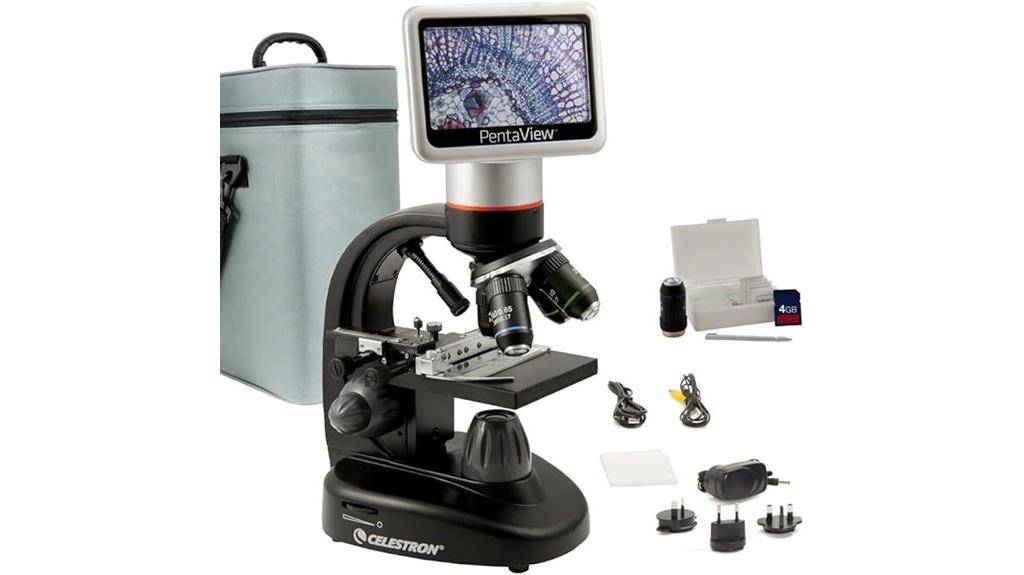
The Celestron PentaView LCD Digital Microscope stands out as an excellent choice for educators, students, and hobbyists who need a versatile, user-friendly device with high-quality imaging. Its 4.3-inch full-color LCD screen, mounted on a 180° rotating head, allows multiple viewers to observe specimens simultaneously, making group activities easier. The 5MP camera captures sharp images and smooth videos at up to 20 fps, with a resolution of 3648×2048 pixels. Equipped with a rotating turret, adjustable lighting, and a mechanical stage, it offers precise control and detailed viewing. Despite some limitations like dim illumination at high magnifications, it provides great value for educational and basic biological applications.
Best For: educators, students, and hobbyists seeking a versatile, easy-to-use digital microscope with high-quality imaging and group viewing capabilities.
Pros:
- Large 4.3-inch full-color LCD screen mounted on a 180° rotating head for shared viewing.
- High-resolution 5MP camera captures detailed images and smooth videos up to 20 fps.
- Includes a rotating turret with multiple magnification options, adjustable lighting, and a mechanical stage for precise control.
Cons:
- Top LED illumination is often insufficient, especially at higher magnifications, requiring external light sources.
- Some quality control issues reported, such as stage droop, loose focus tension, and camera artifacts.
- The LCD resolution and overall build quality are considered dated and less durable compared to higher-end models.
SWIFT SW400 Microscope with Infinity Correction
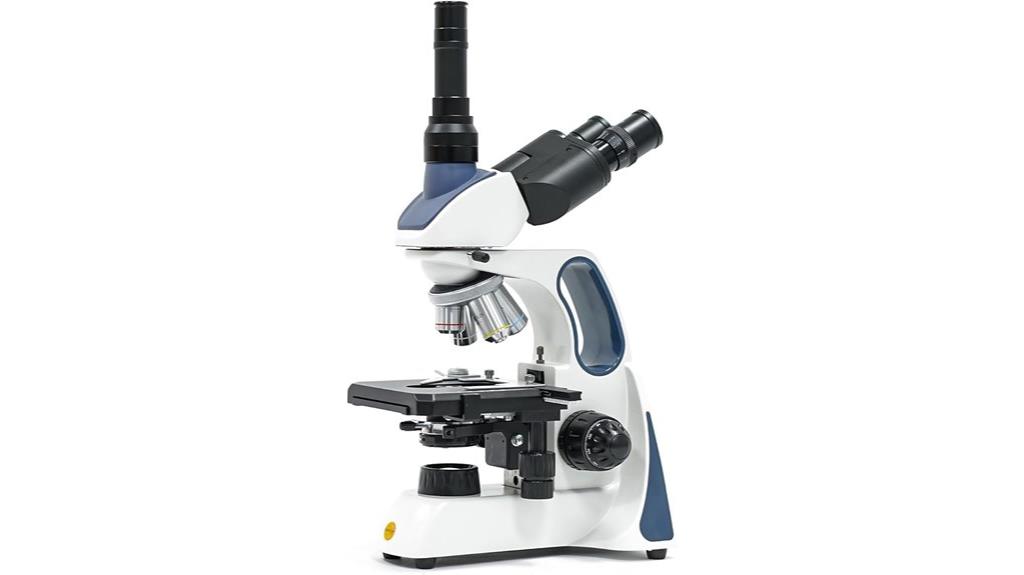
With its infinity-corrected optical system, the SWIFT SW400 Microscope delivers sharp, high-contrast images ideal for detailed biological investigations. It offers 40X to 2500X magnification using infinity-achromatic objectives and wide-field eyepieces, ensuring clarity across multiple levels. The trinocular head includes a dedicated camera port, supporting image capture, livestreaming, and recording. Its sturdy build features a double-layer mechanical stage and precise focusing knobs, providing smooth adjustments. While the camera quality and software have limitations—especially for high-magnification imaging—the microscope remains a versatile, durable choice for research, education, and hobbyist use, balancing affordability with reliable optical performance.
Best For: hobbyists, students, and educators seeking a durable, high-contrast biological microscope with versatile magnification options for educational and research purposes.
Pros:
- Infinity-corrected optical system provides sharp, high-contrast images across multiple magnifications
- Sturdy build with precise focusing knobs and double-layer mechanical stage for smooth operation
- Includes a dedicated trinocular head with camera port suitable for imaging, livestreaming, and recording
Cons:
- Camera resolution and software are limited, especially at higher magnifications and for professional research needs
- Light intensity may be insufficient for some detailed observations without adjustments or additional lighting
- Missing accessories like a storage case may require third-party purchases, increasing overall cost
AmScope T490-DK Compound Trinocular Microscope
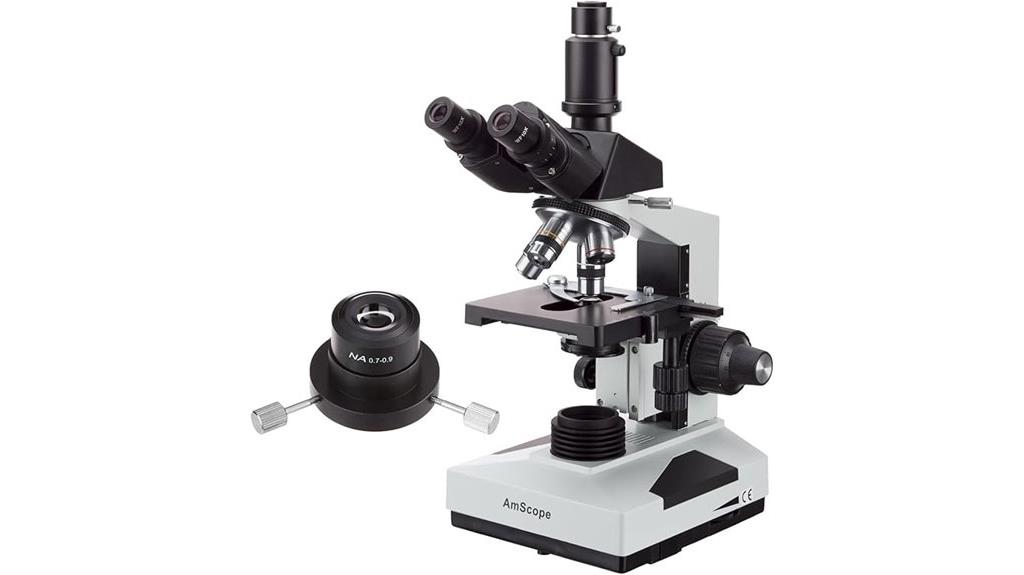
If you need a microscope capable of detailed biological and research work, the AmScope T490-DK compound trinocular microscope stands out thanks to its high magnification range of 40x to 1000x. It features a compound optical system with four DIN achromatic objectives, including spring-loaded 40xS and 100xS for high-detail imaging and oil immersion. The microscope offers brightfield and darkfield illumination with adjustable halogen light, a precise X-Y mechanical stage, and coaxial coarse and fine focus with 0.002mm resolution. Its durable metal body, adjustable interpupillary distance, and trinocular port make it suitable for labs, education, and research, despite mixed customer reviews.
Best For: biological researchers, educators, and professionals needing high-magnification detailed specimen analysis.
Pros:
- Wide magnification range (40x-1000x) suitable for detailed biological and research work.
- Includes spring-loaded objectives and oil immersion for high-resolution imaging.
- Durable metal construction with adjustable interpupillary distance and trinocular port for versatility.
Cons:
- Mixed customer reviews with some reports of blurry objectives and inconsistent image clarity.
- Customer support and after-sales service have been noted as poor by some users.
- Slightly heavy and bulky, which may affect portability and ease of use in some settings.
AmScope T490B-8M Digital Microscope (T490B-8M)
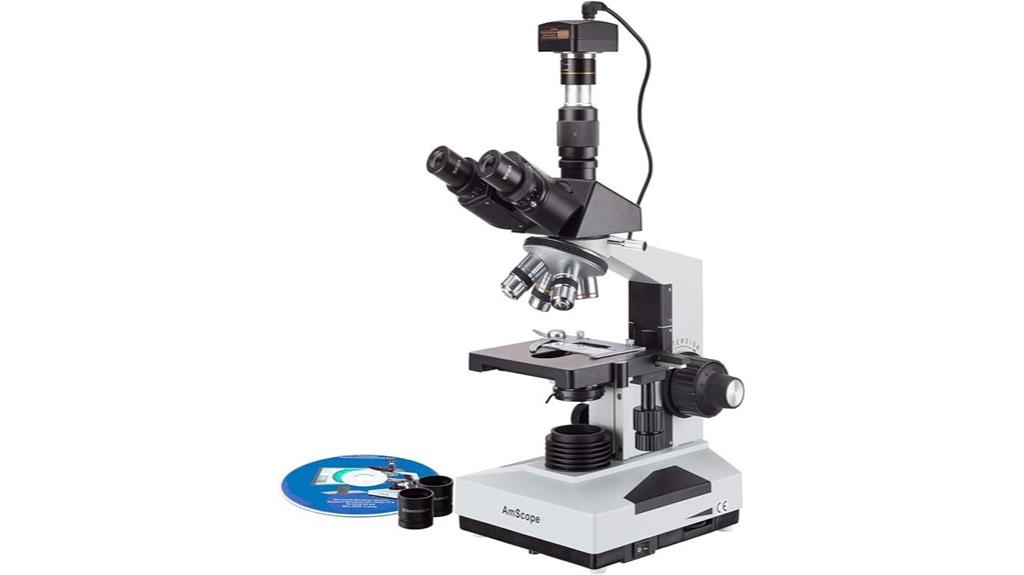
Designed for detailed inspection and precise documentation, the AmScope T490B-8M Digital Microscope stands out with its high-resolution 8MP camera and advanced optical system. It features interchangeable 10x and 20x widefield eyepieces, a four-objective nosepiece, and a mechanical stage for accurate slide positioning. The brightfield halogen illumination, combined with a condenser and iris diaphragm, guarantees ideal lighting. With magnification from 40x to 2000x and precise focusing controls, it’s perfect for research and documentation. The integrated camera streams live footage and captures images in high resolution, making it ideal for detailed analysis and record-keeping in precision engineering applications.
Best For: researchers, educators, and professionals requiring high-resolution imaging and precise documentation in biological, material, or engineering analysis.
Pros:
- High-resolution 8MP camera for detailed image capture and live streaming
- Versatile magnification range from 40x to 2000x with interchangeable eyepieces and objectives
- Durable metal construction with advanced optical and illumination systems for consistent performance
Cons:
- Slightly complex setup may require familiarity with microscopy equipment
- Heavier and bulkier design could be less portable for field use
- Higher price point compared to basic microscopes with lower camera resolutions
AmScope B490B-LED Compound Binocular Microscope
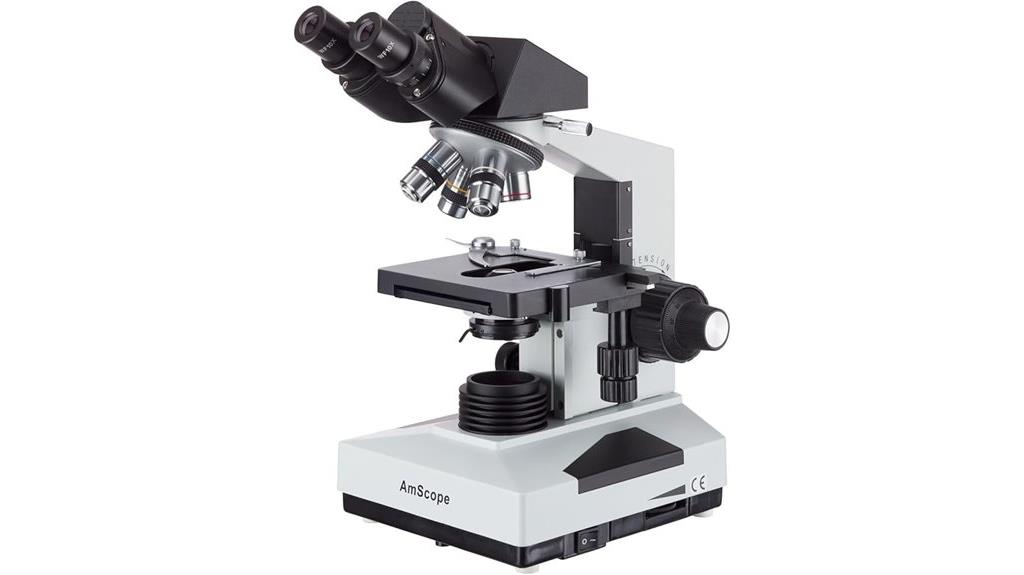
The AmScope B490B-LED compound binocular microscope stands out as an excellent choice for biological researchers, educators, and hobbyists seeking high-quality imaging at an accessible price point. Its durable metal body resists stains and corrosion, ensuring longevity. The sliding head adjusts from 55-75mm for comfortable viewing, while the 10x and 20x widefield eyepieces with a 30-degree tilt reduce eye and neck strain. Equipped with four DIN achromatic objectives—ranging from 4x to 100x oil immersion—it delivers sharp, color-corrected images. Brightfield LED illumination and a robust mechanical stage make it ideal for detailed inspection, dissection, and educational applications.
Best For: biological researchers, educators, and hobbyists seeking a durable, high-quality microscope with versatile magnification and comfortable viewing features.
Pros:
- Sturdy metal body resistant to stains and corrosion for long-term durability
- Adjustable sliding head and inter-pupillary distance for customized comfort
- Brightfield LED illumination with precise light control and high-resolution optics
Cons:
- Overall weight may be heavy for portable use despite dimensions being manageable
- Some users suggest upgrading objectives for clearer images at higher magnifications
- Slightly higher price point compared to basic microscopes with similar features
Wireless In-Ear Monitor System with 4 Receivers
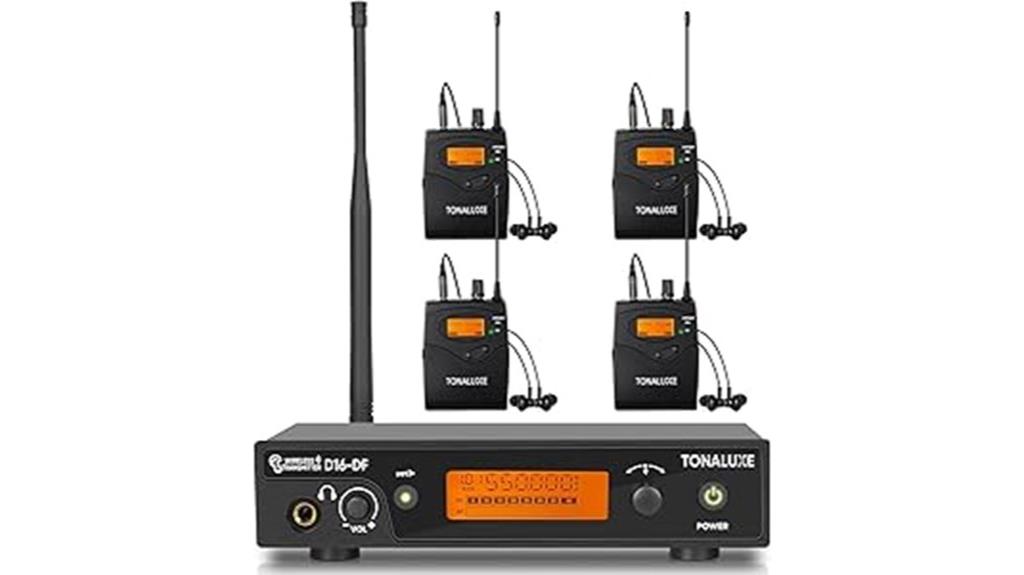
For performers and audio engineers seeking seamless stage monitoring, the Wireless In-Ear Monitor System with 4 Receivers offers reliable, high-fidelity sound with minimal setup. Operating on UHF frequencies with 100 selectable channels and advanced PLL technology, it minimizes signal interruptions and guarantees a stable connection across various stage conditions. The system provides an impressive 80-meter range, supporting clear, zero-delay audio for professional performances. With automatic pairing, RF signal indicators, and a locking feature, it personalizes and secures your settings. Compatible with multiple devices and easy to use, this system delivers crisp, vibrant sound in a durable, lightweight design ideal for live gigs and studio work.
Best For: performers, musicians, and audio engineers seeking reliable, high-quality in-ear monitoring for live performances or studio use.
Pros:
- Stable connection with 100 selectable UHF channels and advanced PLL technology minimizes signal interruptions
- Long 80-meter range with zero-delay, high-fidelity sound suitable for professional stage monitoring
- Durable and lightweight design with user-friendly features like automatic pairing and RF signal indicators
Cons:
- Limited to mono output, which may not suit users needing stereo monitoring
- Manual frequency tuning required, potentially adding setup time during performances
- Basic earbuds and plastic build may affect long-term durability and sound fidelity compared to higher-end systems
AmScope T490A-DK Compound Trinocular Microscope
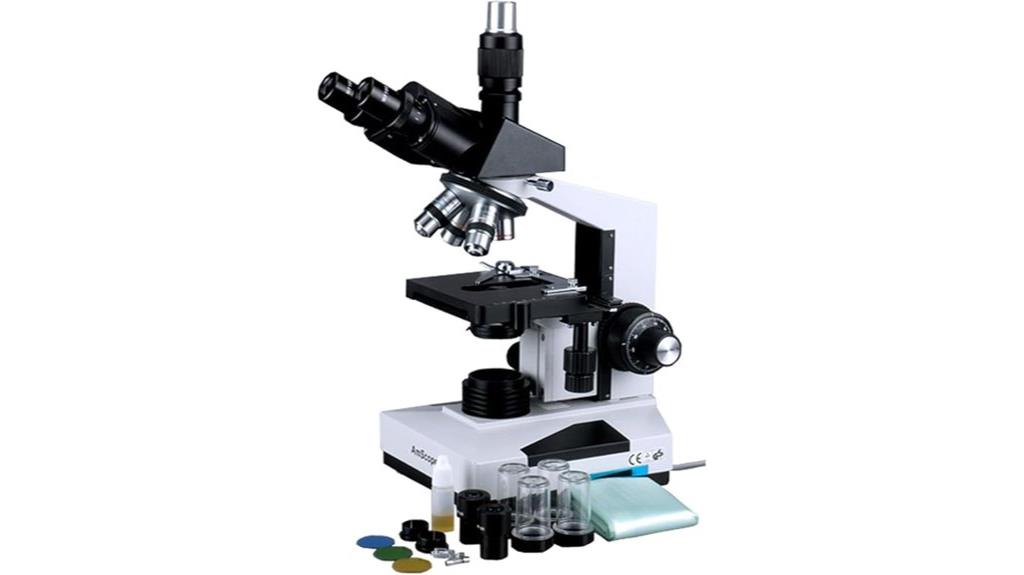
If you’re seeking a versatile microscope that balances high-quality optics with user comfort, the AmScope T490A-DK Compound Trinocular Microscope is an excellent choice. Its sliding head with a vertical camera mount and 360-degree rotation makes sharing and detailed viewing easy. The fixed 30-degree inclination reduces eye and neck strain during long sessions. Equipped with achromatic objectives, brightfield and darkfield illumination, and a precise mechanical stage, it supports magnifications up to 1600x. Durable, corrosion-resistant, and adaptable, this microscope is perfect for biological research, education, and specimen analysis. Its exhaustive features deliver clarity, stability, and ease of use in demanding scientific environments.
Best For: biological researchers, educators, and hobbyists seeking a versatile, high-quality compound microscope for detailed specimen analysis and educational use.
Pros:
- High magnification range up to 1600x with achromatic objectives for clear, detailed images
- Ergonomic design with a 30-degree inclined, rotatable head to reduce eye and neck strain during extended use
- Robust, corrosion-resistant metal body and comprehensive accessories for durability and ease of use
Cons:
- Moderate customer satisfaction ratings, averaging 3.3 out of 5 stars
- Relatively heavy at approximately 16 pounds, which may impact portability
- Requires separate purchase of a camera for digital imaging, adding to overall cost
Linear Stage Tuning and Displacement Station
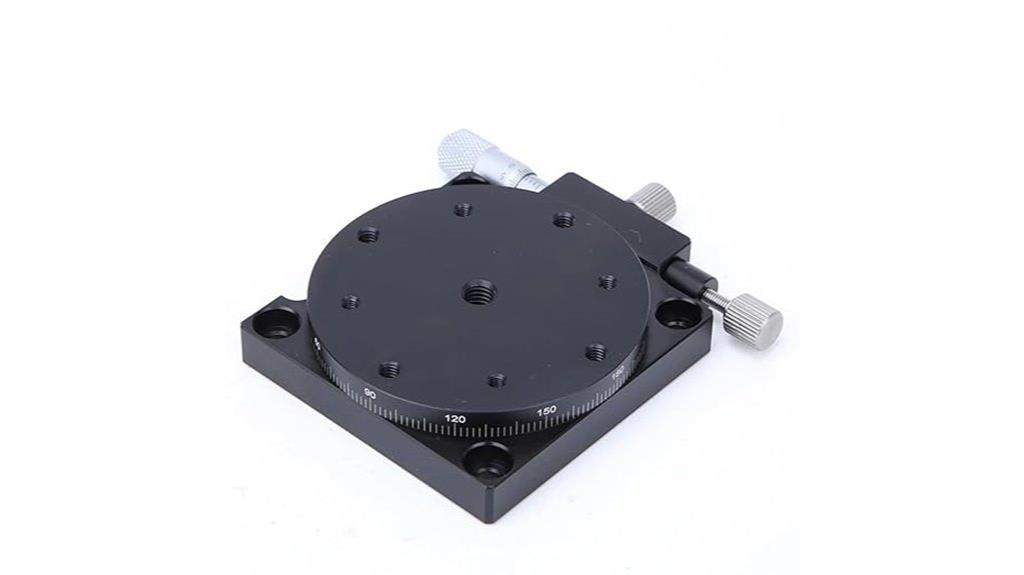
When aiming for ultra-precise displacement control, linear stage tuning and displacement stations stand out as essential tools. They excel in applications like production machinery, testing, optical measurements, and fine-tuning movements requiring high accuracy and smooth operation. These devices feature high precision, built-in compatibility, and durability, thanks to components like carbide side heads and plated fine adjustment knobs. The micrometer-driven mechanism provides both coarse and fine adjustments—360 degrees manual coarse and about ±5 degrees fine—ensuring precise control. Constructed with linear roller bearings and robust components, they deliver stability and accurate displacement, making them vital for tasks demanding meticulous positioning.
Best For: professionals and researchers requiring high-precision displacement control in production, testing, optical measurement, and fine-tuning applications.
Pros:
- High precision and smooth operation for accurate positioning
- Durable design with carbide side heads and plated fine adjustment knobs
- Easy to manually adjust via micrometer with coarse and fine control
Cons:
- May require skilled operation for optimal fine-tuning
- Manual adjustments could be time-consuming for repetitive tasks
- Limited to applications where manual fine adjustments are sufficient
ICUIXIAN Video Wall Controller with 4×1, 3×1, 2×1, 2×2, 1×2, 1×3, 1×4 4K@60Hz Support
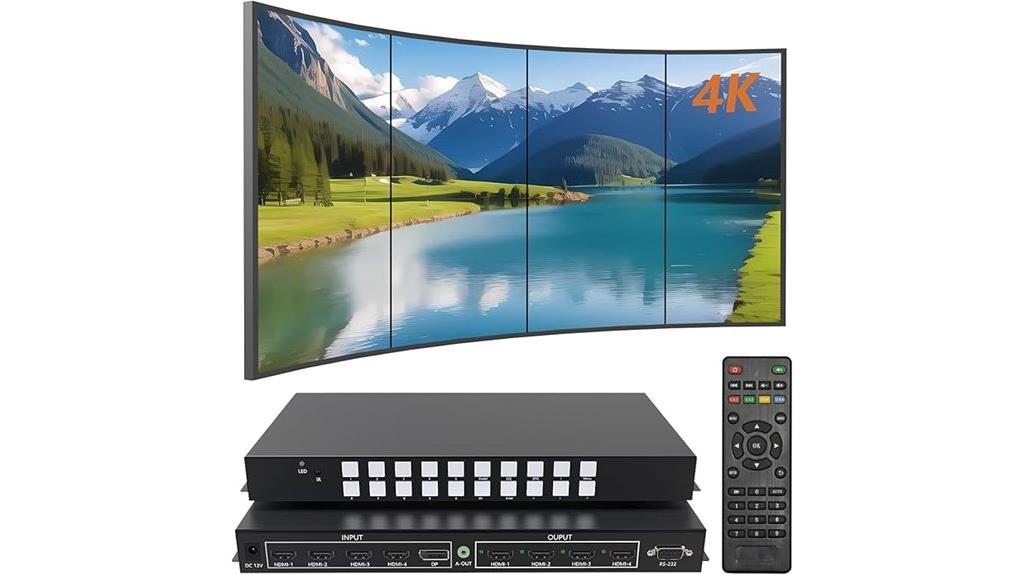
The ICUIXIAN Video Wall Controller stands out as an ideal choice for professionals seeking flexible and high-quality display solutions, thanks to its support for multiple configurations like 4×1, 3×1, 2×2, and more. It offers 4K@60Hz input-output resolution with four HDMI and one DisplayPort channels, enabling seamless signal switching. The controller supports various rotation modes—90°, 180°, and 270°—allowing versatile portrait and landscape displays. Its dual functionality as a video wall processor and HDMI matrix switch provides exceptional flexibility for complex setups. Control options include remote, panel, and RS-232, ensuring smooth operation in diverse professional environments.
Best For: professionals and organizations needing versatile, high-resolution video wall solutions with flexible configurations and seamless signal switching.
Pros:
- Supports multiple display configurations including 4×1, 3×1, 2×2, and more for versatile setups
- Offers 4K@60Hz resolution with multiple input channels (HDMI and DisplayPort) for high-quality video support
- Provides multiple control options (remote, panel, RS-232) for convenient operation in various environments
Cons:
- Dimensions (6 x 12.5 x 3 inches) may limit portability for some users
- First available in November 2024, so long-term user feedback may be limited
- Requires compatibility with other equipment supporting HDMI 2.0 and DisplayPort for optimal performance
35KG Digital Motor Servo 7.4V High Speed Waterproof Gear
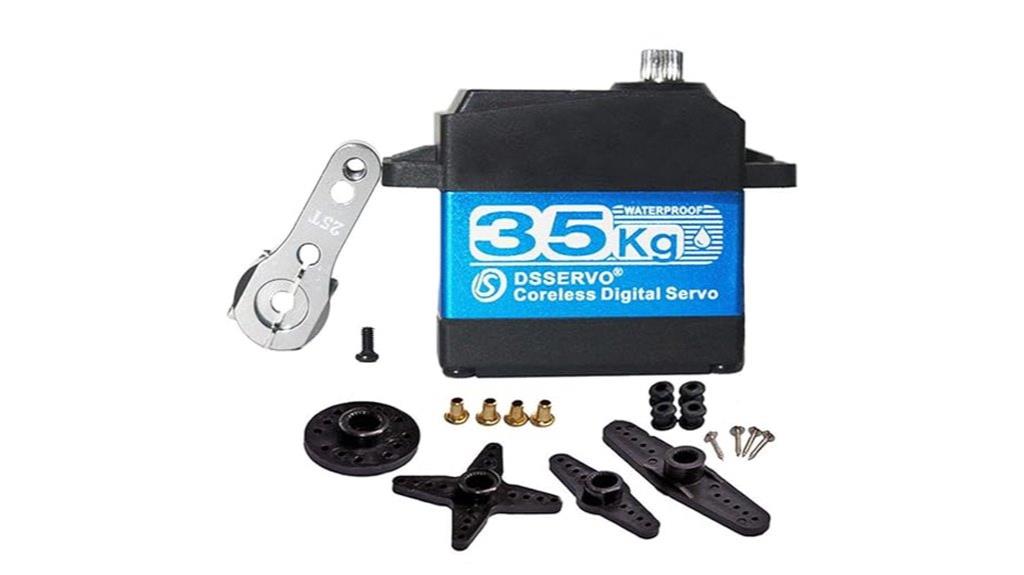
The KG Digital Motor Servo 7.4V High Speed Waterproof Gear stands out as a top choice for RC enthusiasts needing reliable, high-torque, waterproof servos. With a 35KG stall torque and IP66 rating, it handles heavy-duty applications and harsh environments effortlessly. Its stainless steel gears guarantee durability, while the high-speed response and 270° control angle enhance precision. Operating efficiently at 7.4V, it offers smooth, responsive movements ideal for crawlers, trucks, and buggies. The servo’s robust build, combined with low power consumption, makes it perfect for demanding RC projects. It’s a dependable, high-performance solution for serious hobbyists.
Best For: RC hobbyists and enthusiasts seeking a high-torque, waterproof servo for demanding crawlers, trucks, and buggies that require precise control and durability in harsh environments.
Pros:
- High stall torque of 35KG for heavy-duty applications
- Waterproof IP66 rating suitable for outdoor and rugged use
- Durable stainless steel gears and robust build for long-lasting performance
Cons:
- May be overkill for basic or stock RC setups
- Installation might require adapters or modifications for perfect fit
- Longer cable length could pose management challenges during installation
Factors to Consider When Choosing High‑Resolution Rotation Stages
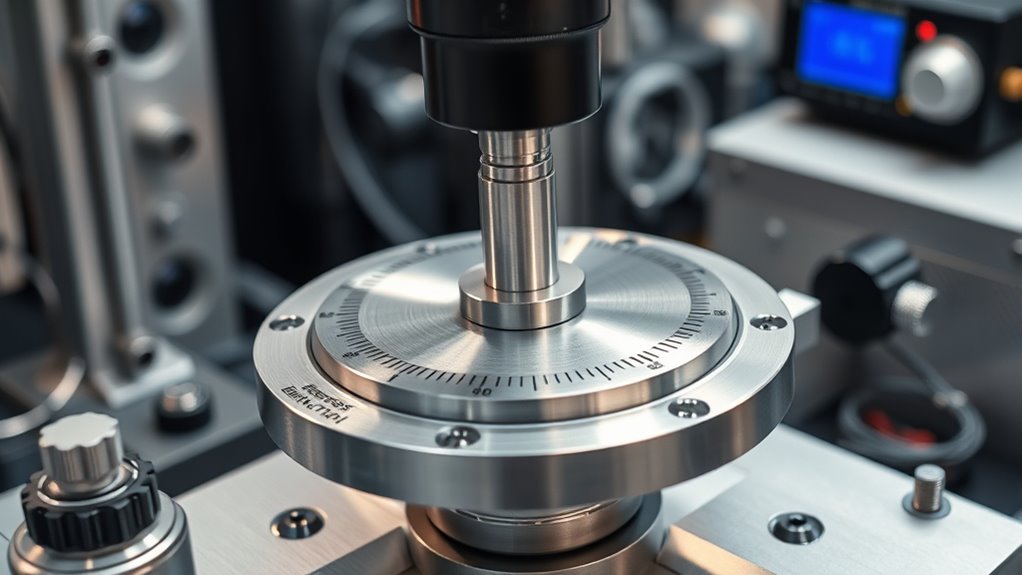
When selecting a high-resolution rotation stage, I focus on key factors like measurement accuracy, smoothness of movement, and load capacity. It’s also important to take into account how easily the stage can be adjusted or calibrated, as well as its compatibility with existing equipment. These points ensure I choose a stage that meets both precision and operational needs.
Precision Measurement Capabilities
Achieving precise angular measurements with high-resolution rotation stages depends on selecting models equipped with fine adjustment mechanisms capable of measuring movements as small as 0.001° to 0.002°. These stages often feature graduated vernier scales or digital encoders, allowing for exact readings and excellent repeatability, which are critical for detailed measurement tasks. To guarantee sub-degree accuracy, it’s essential that the stage has low backlash, minimal play, and high-quality bearings to provide stable, consistent positioning. Advanced stages also incorporate calibration features and digital readouts, enabling users to verify and record angular displacement accurately. Additionally, high-precision gearing and tension control reduce drift and hysteresis, maintaining measurement integrity during extended or sensitive experiments. These capabilities are fundamental for reliable, high-precision engineering applications.
Smoothness of Rotation
Ensuring smooth, backlash-free rotation is essential for high-resolution stages to deliver precise and repeatable positioning. I look for stages with high-quality bearings, such as ball or roller bearings, which enable consistent, fluid movement. Fine adjustment controls with minimal play are crucial for making incremental, accurate rotations at high resolution. The drive system’s torque and motor strength directly influence smoothness, especially when handling loads or accessories. Proper tension and tension adjustment features help maintain steady rotation, preventing drift or unintended movement during sensitive operations. When selecting a stage, I prioritize those designed to minimize resistance and backlash, ensuring seamless motion. This focus on smoothness guarantees reliable, high-precision performance, vital for demanding applications in precision engineering.
Load Capacity and Stability
Selecting a high-resolution rotation stage that can handle your load requirements is essential for maintaining accuracy and preventing damage. Make sure the stage’s load capacity exceeds the weight of your specimens and accessories to avoid deformation or operational issues. Check that stability features like locking mechanisms and low-profile designs effectively minimize wobble and keep your setup precise under load. The material and construction quality are critical—heavy-duty steel or aluminum alloys typically support higher weights and enhance stability. Always review the manufacturer’s maximum weight rating and choose a stage with at least 20-50% extra capacity for safety and durability. Additionally, assess how the design manages vibrations and flexing, opting for models with reinforced frames and support structures to ensure consistent, stable rotation.
Adjustment and Calibration Ease
When choosing a high-resolution rotation stage, it’s essential to focus on how easily you can adjust and calibrate it to maintain precision. Look for stages with precise, micrometer-driven mechanisms that allow fine calibration and accurate positioning. User-friendly controls like knurled knobs, digital readouts, or motorized systems make adjustments easier, reducing manual effort and improving repeatability. Clear reference marks or digital feedback simplify calibration, helping verify the stage’s angular position quickly and reliably. Low backlash and minimal play in the adjustment mechanisms are crucial for accurate calibration and consistent positioning during delicate tasks. Additionally, compatibility with calibration tools and standardized measurement interfaces streamlines verification and maintenance, ensuring your rotation stage remains precise over time.
Compatibility With Equipment
Choosing a high-resolution rotation stage that seamlessly integrates with your equipment requires careful attention to compatibility factors. First, verify the mounting interface matches your setup, whether it’s dovetail, T-slot, or custom fittings. Check that the size and load capacity suit your instruments or samples, avoiding overstress or instability. Confirm that the rotation axis’s diameter and hole patterns align with your existing setup or accessories for smooth integration. Additionally, verify support for necessary attachment points—like encoders, sensors, or optical components—to enhance functionality. Don’t forget to assess the control interface and power requirements, ensuring they’re compatible with your current systems. Addressing these compatibility considerations helps prevent installation issues and guarantees reliable, precise operation.
Durability and Material Quality
Durability and material quality play a pivotal role in ensuring high-resolution rotation stages deliver consistent, precise performance over time. I look for stages made from tough materials like hardened stainless steel or anodized aluminum, which resist deformation and withstand frequent use. The right material choice also boosts resistance to corrosion, especially in humid or chemical environments, ensuring long-term reliability. Precision-machined components, such as ground and lapped surfaces, provide stability and smooth rotation, minimizing backlash and mechanical play. Reinforced bearing systems, like linear roller or ball bearings, are essential for maintaining alignment under high loads. Ultimately, high material quality means the stage resists wear and fatigue, extending its lifespan in demanding scientific and industrial applications.
Frequently Asked Questions
How Do High-Resolution Rotation Stages Improve Precision in Engineering Applications?
High-resolution rotation stages improve precision by allowing me to make incredibly fine adjustments, often at the sub-arcsecond level. This means I can position components with exceptional accuracy, reducing errors in my engineering projects. The smooth, controlled movements help me achieve repeatability and stability, which are vital for delicate tasks like microscopy, laser alignment, or optical experiments. Overall, they guarantee my work is precise, reliable, and consistent.
What Are the Key Differences Between Manual and Motorized Rotation Stages?
They say, “The devil is in the details,” and that’s true for rotation stages. Manual stages require physical adjustment, giving you control but lacking speed. Motorized stages, on the other hand, let you precisely control rotation via motors, offering automation and repeatability. They’re ideal for complex tasks. I prefer motorized for high precision, but manual stages work well for simple, occasional adjustments. It’s all about your project needs.
Which Materials Are Best Suited for High-Precision Rotation Stage Components?
I find that materials like granite, aluminum, and stainless steel are ideal for high-precision rotation stage components. Granite offers excellent stability and minimal thermal expansion, making it perfect for ultra-precise applications. Aluminum is lightweight and easy to machine, while stainless steel provides durability and corrosion resistance. I always choose materials based on the specific precision needs, balancing stability, weight, and environmental factors to guarantee peak performance.
How Do Environmental Factors Affect Rotation Stage Accuracy?
Environmental factors like temperature fluctuations, vibrations, and humidity directly impact rotation stage accuracy. I’ve found that even slight changes can cause expansion or contraction of components, leading to misalignments. Vibrations from nearby equipment can introduce errors, while humidity can affect sensitive materials. To maintain precision, I always guarantee stable conditions, use vibration isolation, and select materials resistant to environmental changes, keeping my stages as accurate as possible.
What Maintenance Routines Ensure Long-Term Performance of High-Resolution Stages?
You might think maintenance is routine, but neglecting it can silently sabotage your stage’s precision. I always inspect and clean the bearing surfaces and optical encoders regularly, ensuring no dust or debris compromise performance. Applying proper lubrication and checking for alignment drifts keeps the stage responsive. Periodic calibration and monitoring feedback data reveal subtle issues early, preventing costly downtime and preserving long-term accuracy. Don’t underestimate the power of consistent care.
Conclusion
As I explored these high-resolution rotation stages, I couldn’t help but notice how each one seemed perfectly suited for precision, almost like they were made to complement my projects. It’s funny how, in this journey of discovery, selecting the right stage feels like finding the missing piece to a puzzle I didn’t know I was solving. Sometimes, the best choices come when you least expect it—just like stumbling upon the perfect tool when you need it most.
